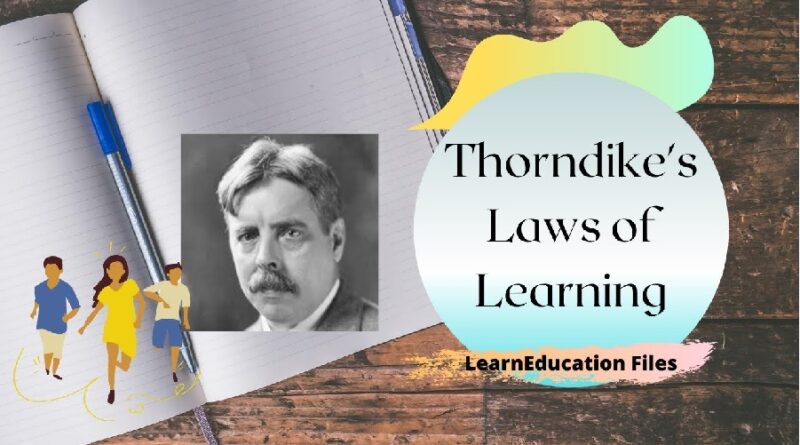What are the Secondary Laws of Learning by Thorndike
Edward Lee Thorndike adopted an experimental approach so as to learn more about animal behavior. He undertook experiments using cats, dogs, and chicks and wrote a thesis called ‘Animal Intelligence: An Experimental Study of the Associate Processes in Animals. This thesis became the very basis of Thorndike’s Law of Effect, one of the primary laws rolled out by Thorndike.
As per the law of effect, the bond between a stimulus and response becomes stronger if such a stimulus leads to a response that is rewarding or satisfying. However, the bond between a stimulus and response weakens if such a stimulus results in a response that is punishing or unsatisfactory.
Thus, as per Thorndike, behaviorism is based on the interaction between stimulus and response. In other words, we humans act or behave in a particular way as an outcome of their vulnerability to a complicated set of stimuli.
Also, these behaviors or responses to a particular set of stimuli develop eventually, over a period of time.
If explained empirically, say a situation ‘S’ leads to a host of responses. Further, one of the responses ‘R’ results in satisfaction ‘SR’ of the human entity. Now, this satisfaction develops a bond between the situation ‘S’ and the response ‘R’.
Due to this bond, the response ‘R’ has a higher probability of occurring whenever similar circumstances occur. This relationship between stimulus and response based on the reinforcers (satisfiers) is also called Thorndike instrumental conditioning.
Thorndike Law of Effect Examples
- An individual getting motivated to perform better at the workplace due to the reward and appreciation he received for his innovative ideas.
- A student is motivated to study as he is encouraged to study the subject of his interest.
Apart from the Law of Effect, Thorndike also gave a host of secondary laws. These are called secondary laws of learning by Thorndike. Let’s have a look at each of them.
Secondary Laws of Learning by Thorndike
According to Thorndike’s law of Connectionism, learning is the outcome of the clear connections a person makes between the information it is provided with. In other words, a person develops associations or connections between a stimulus and response.
Now, as per Thorndike, these connections are developed as a result of various trials and errors undertaken by a person. To explain this law of connectionism, Thorndike came out with a number of secondary laws which are as follows.
1. Learning by Trial and Error
This principle states that a human entity develops connections between a stimulus and response after a host of trials and errors. He was of the view that learning happens as a result of trial and error.
2. Effect and Exercise Laws
The law of effect and exercise is further categorized into the law of use and misuse. Accordingly, as per the law of use, the connection between a stimulus and response becomes stronger if the entity makes such a response repeatedly to such a stimulus.
On the other hand, the law of misuse states that the connection between a stimulus and response weakens if the entity does not develop any such association between the stimulus and response.
3. Law of Readiness
Through this principle, Thorndike suggested that the animal or human entity must be prepared to showcase a learned habit. Accordingly, a response is satisfying or rewarding if the animal or human entity has the urge to take up the activity.
Likewise, the response or activity is punishing if the animal or human entity is not willing to take up the activity.
4. Principle of Associative Shifting
As per this principle, a human entity or an animal responds to a given stimulus which is completely different much in the same way as it responded to a particular stimulus earlier. This happens only if there are minor changes in the current stimulus relative to the previous stimulus.
5. Identical Theory of Transfer
This principle states that things learned previously encourage future learning. However, this new learning takes place only to the degree the new tasks are made of elements that relate to the tasks done previously.
6. Law of Multiple Responses
Th law of multiple responses states that an animal or a human entity conatinues to respond to a given stimulus until it comes up with a response that is satisfying or rewarding.
7. Prepotency of Elements
This principle states that a human entity is more likely to respond to athe important elements of a given stimulus. Similarly, he is less probable to respond to insignificant elements of the stimulus.
8. Law of Analogy
In this principle, Thorndike lays out that a human entity puts to use its previous experience to respond to a given situtatiom. Thus, it responds to a given stimulus because of the similarity of the current circumstances with his previous experience.
9. Law of Associative Shifting
In this law, Thorndike points out that responses that human entity learns in respect of specific stimuli can also learn to make same response to other stimuli, given there is no change in the overall condition. This means human entity shifts response from one stimulus to another.
10. Law of Availability
Law of availability states that if the human entity successfully completes his learning and makes connections appropriately, it can make responses to stimuli easily. Thus, learning essential skills learnt in prior stages rests on how well the human entity is able to make use of the important information. write for us law submit legal article post.



